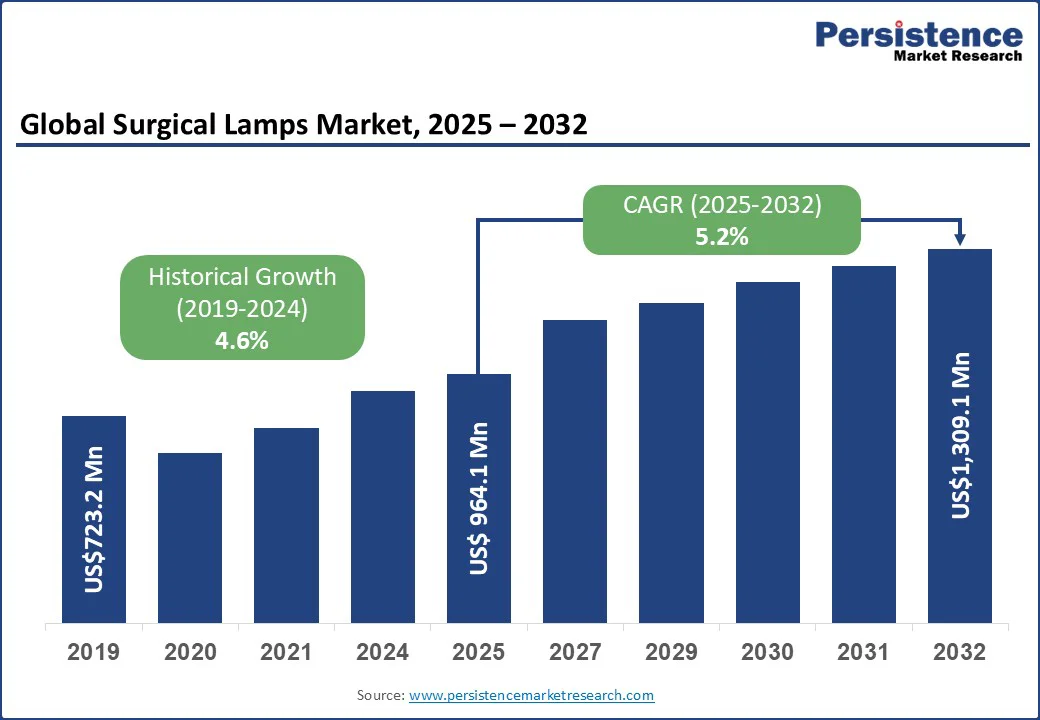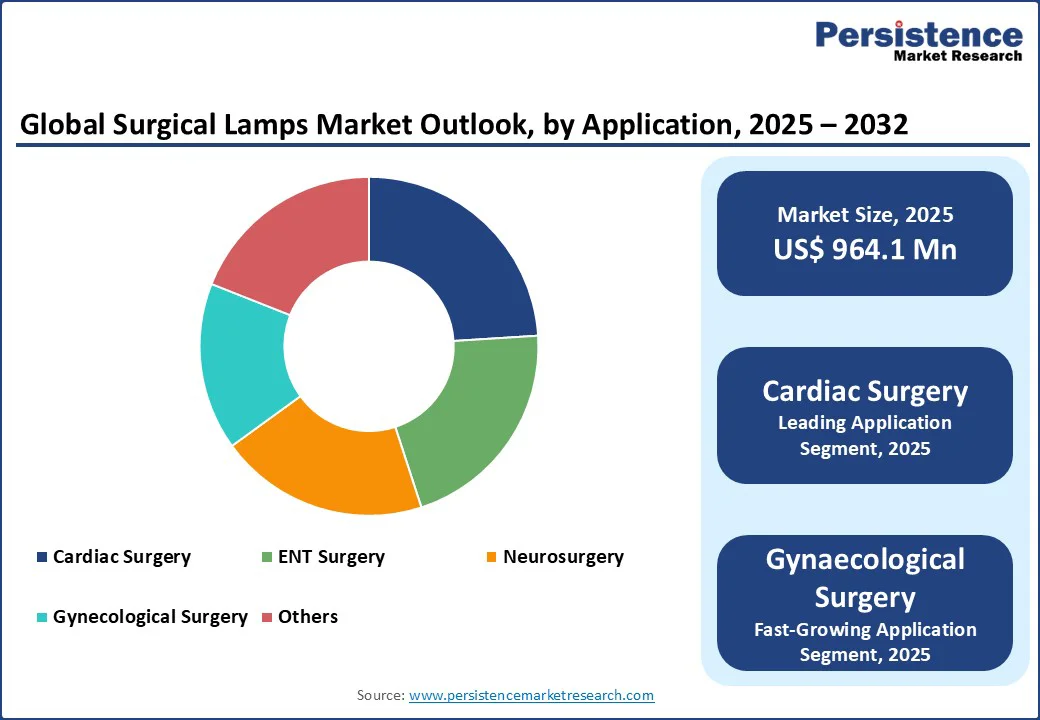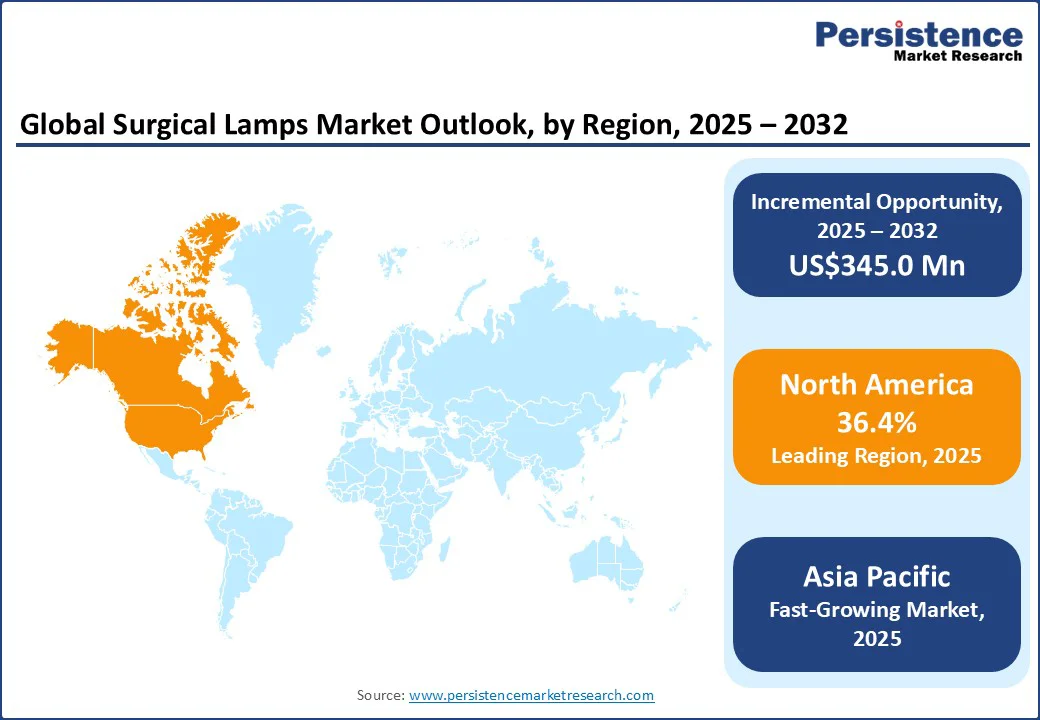ID: PMRREP2817| 188 Pages | 23 Sep 2025 | Format: PDF, Excel, PPT* | Healthcare

The global surgical lamps market size is likely to be valued at US$964.1 Mn in 2025 and is expected to reach US$1,309.1 Mn by 2032, growing at a CAGR of 5.2% during the forecast period from 2025 to 2032, driven by the demand for healthcare facilities such as surgeries and invasive procedures.
Technological advancements have eminently transformed the market over the years, and will continue to do so through 2032.
Key Industry Highlights

| Key Insights | Details |
|---|---|
| Surgical Lamps Market Size (2025E) | US$964.1 Mn |
| Market Value Forecast (2032F) | US$1,309.1 Mn |
| Projected Growth (CAGR 2025 to 2032) | 5.2% |
| Historical Market Growth (CAGR 2019 to 2024) | 4.6% |
The surgical lamps market is primarily driven by the rising number of surgical procedures worldwide. According to the CDC, over 51 million inpatient surgeries are performed every year in the U.S. alone, highlighting the growing demand for advanced operating room equipment. Aging populations, coupled with the increasing prevalence of chronic illnesses such as cardiovascular disease and cancer, continue to raise the need for surgeries across regions.
Another strong driver is the shift from halogen to LED surgical lamps, as LEDs provide brighter illumination, better shadow control, lower heat emission, and significant energy savings. Hospitals and surgical centers are investing in these technologies to improve surgical outcomes and reduce operating costs.
In addition, governments are increasing healthcare budgets to modernize medical infrastructure, especially in developing countries, further supporting market growth. Together, these factors strongly push the global demand for surgical lamps in hospitals and ambulatory surgical centers.
A key restraint for the surgical lamps market is the high upfront cost of advanced lighting systems, particularly LED and ceiling-mounted variants with integrated imaging or touchless controls. Smaller hospitals, rural clinics, and facilities in developing regions often struggle to justify such investments given budget limitations.
Additionally, regulatory complexities across countries require extensive testing, certifications, and compliance with safety standards, delaying product launches and increasing costs for manufacturers. Inadequate infrastructure in emerging markets, such as unstable electricity supply and a shortage of skilled maintenance staff, further limits adoption.
Moreover, many hospitals continue relying on halogen lamps due to their lower initial cost, despite their shorter lifespan and higher energy use, slowing the LED transition. Together, these factors hinder faster global market penetration.
The surgical lamps market is set to benefit from strong growth opportunities, especially in emerging economies, where governments are investing heavily in healthcare infrastructure. Countries across Asia, Latin America, and the Middle East are building new hospitals, upgrading operating rooms, and adopting modern surgical equipment, creating fresh demand for advanced lighting systems.
The shift toward energy-efficient LED technology also opens opportunities, as hospitals aim to reduce electricity consumption and heat in operating rooms while improving lighting quality.
Furthermore, the growing popularity of ambulatory surgical centers (ASCs), which perform increasing numbers of outpatient procedures, is boosting demand for compact and cost-effective surgical lighting solutions. Manufacturers also have scope to innovate with smart features such as wireless controls, shadow reduction, and integrated imaging, making lamps more user-friendly and efficient. Together, these factors provide a strong platform for long-term market expansion globally.
In 2025, halogen surgical lights are anticipated to dominate the market with a share of 55%, primarily due to their easy availability and comparatively lower upfront costs. Their steady light output and high color accuracy make them suitable for surgeries where precise visualization of tissues is essential, supporting their strong market presence. The market is gradually shifting toward LED surgical lamps, which are expected to record the fastest growth during the forecast period.
LEDs offer multiple benefits, including their reduced power consumption, longer operational life, and significantly lower maintenance costs. They also generate less heat, improving comfort in operating rooms. Moreover, their superior color rendering index allows surgeons to see true tissue colors with greater clarity, improving surgical outcomes. These advantages are encouraging hospitals and surgical centers to increasingly adopt LED systems for future upgrades.
The cardiac surgery segment accounted for a major share of the surgical lamps market in 2025. Cardiac procedures are highly complex, requiring enhanced illumination and precision. Globally, over one million cardiac surgeries are performed annually, with some estimates reaching 1.5 million, highlighting strong demand for advanced surgical lighting (National Library of Medicine).
Features such as adjustable color temperature support accurate visualization, while the growth of minimally invasive cardiac interventions increases the need for specialized lamps to illuminate confined surgical fields. Meanwhile, the neurosurgery segment is expected to grow at a notable pace.
The rising elderly population, prone to neurological conditions such as brain tumors, Alzheimer’s, and Parkinson’s, fuels demand. According to Cancer Research UK, about 12,700 new cases of brain and CNS tumors are reported annually. High-quality surgical lights reduce errors and aid in better outcomes, boosting adoption in neurosurgical procedures.

North America is expected to lead with a market share of 36.4% in 2025. According to the American Hospital Association (AHA), as of their 2025 data (survey year 2023), there are 6,093 hospitals in the U.S., including 5,112 community hospitals. These large numbers of hospitals drive strong demand for surgical lamps, especially as many facilities upgrade aging operating room equipment.
The U.S. spends heavily on modern medical infrastructure and advanced surgical lighting systems that meet stringent quality and safety standards. LED lighting systems are increasingly preferred for their energy efficiency, lower heat output, and longer lifespan.
Regulatory and accreditation requirements, along with hospital sustainability initiatives, are pushing for the adoption of advanced lighting with features such as sterile handles, shadow control, and higher lux levels.
In addition, the shift toward performing more outpatient and ambulatory surgeries increases the demand for surgical lamps that are compact, flexible, and cost-efficient. Overall, growth in hospital admissions (34.4 million in 2023) and the high number of staffed beds (over 913,000) suggest ongoing replacement and new installations of surgical lamps in North America.
Asia Pacific is expected to be the fastest-growing regional market for surgical lamps. Governments in India, China, Southeast Asia, and Australia are investing heavily in hospital infrastructure, building new hospitals and upgrading older ones.
The rising middle class, increasing healthcare access, and growing medical tourism are also supporting demand for better-quality surgical lighting. In many countries, there is still high use of halogen lighting or lower-quality lamps, which present a large replacement opportunity. LED penetration is accelerating due to its energy cost savings, longer lifespan, and better lighting performance.
The demand for ambulatory surgical centers and outpatient surgical services is also growing, which tends to favor cost-efficient, compact lighting solutions. Regulatory harmonization and the adoption of standards are improving slowly, which lowers barriers for international device suppliers.
Rural regions also present emerging opportunities, as improvements in electricity access, healthcare infrastructure, and medical staff training are expected to drive adoption of advanced surgical lighting in smaller hospitals over time.

The global surgical lamps market is moderately consolidated, with key players focusing on LED innovation, ergonomic design, and energy efficiency. Leading companies such as Stryker, Hill-Rom Holdings, Steris, and Getinge dominate through strong distribution networks and R&D investments.
Regional players add competition with cost-effective solutions. Strategic collaborations, acquisitions, and hospital infrastructure projects continue to shape market dynamics, with emphasis on sustainability and advanced integrated operating-room technologies.
The surgical lamps market is projected to be valued at US$964.1 Mn in 2025.
Rising surgical procedures, healthcare infrastructure investments, and rapid adoption of energy-efficient LED lighting systems strongly drive market growth.
The surgical lamps market is poised to witness a CAGR of 5.2% between 2025 and 2032.
Emerging economies, demand for ambulatory surgical centers, and innovations such as smart illumination and integrated imaging create significant growth opportunities.
The key players include Stryker Corporation, Steris Corporation, A-dec Inc., BihlerMed, SKYTRON, LLC.
| Report Attribute | Details |
|---|---|
| Historical Data/Actuals | 2019 - 2024 |
| Forecast Period | 2025 - 2032 |
| Market Analysis | Value: US$ Mn |
| Geographical Coverage |
|
| Segmental Coverage |
|
| Competitive Analysis |
|
| Report Highlights |
|
By Technology
By Application
By End-user
By Region
Delivery Timelines
For more information on this report and its delivery timelines please get in touch with our sales team.
About Author